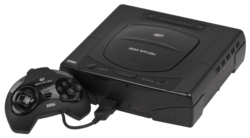
Back Sega Saturn AN سيغا ساترن Arabic سيجا ساترن ARZ Sega Saturn AST Sega Saturn Azerbaijani Sega Saturn Byelorussian Sega Saturn Breton Sega Saturn Catalan Sega Saturn Czech Sega Saturn Danish
Western and Eastern logos | |
Top: Model 1 from North America Bottom: Model 2 from Japan | |
| Manufacturer | Sega |
|---|---|
| Type | Home video game console |
| Generation | Fifth |
| Release date | |
| Lifespan | 1994–2000 |
| Introductory price |
|
| Discontinued | |
| Units sold | 9.26 million |
| Media | CD-ROM, CD+G, CD+EG, Video CD, Mini CD, Photo CD, e-book[2] |
| CPU | 2× Hitachi SH-2 @ 28.6 MHz |
| Memory | 2 MB RAM, 1.5 MB VRAM, 512 KB sound RAM, expandable with Extended RAM Cartridge |
| Storage | Internal RAM, cartridge |
| Graphics | VDP1 & VDP2 video display processors |
| Sound | Yamaha YMF292 |
| Online services | Sega NetLink |
| Predecessor | Sega Genesis |
| Successor | Dreamcast |
The Sega Saturn[a][b] is a home video game console developed by Sega and released on November 22, 1994, in Japan, May 11, 1995, in North America, and July 8, 1995, in Europe. Part of the fifth generation of video game consoles, it is the successor to the successful Genesis. The Saturn has a dual-CPU architecture and eight processors. Its games are in CD-ROM format, including several ports of arcade games and original games.
Development of the Saturn began in 1992, the same year Sega's groundbreaking 3D Model 1 arcade hardware debuted. The Saturn was designed around a new CPU from the Japanese electronics company Hitachi. Another video display processor was added in early 1994 to better compete with the 3D graphics of Sony's forthcoming PlayStation.
The Saturn was initially successful in Japan but not in the United States, where it was hindered by a surprise May 1995 launch, four months before its scheduled release date. After the debut of the Nintendo 64 in late 1996, the Saturn rapidly lost market share in the U.S., where it was discontinued in 1998. At 9.26 million units sold worldwide, the Saturn is considered a commercial failure; this was affected by the cancellation of Sonic X-treme, planned as the first 3D entry in Sega's popular Sonic the Hedgehog series. The Saturn was succeeded in 1998 by the Dreamcast.
Although the Saturn has several well-regarded games, including Nights into Dreams, the Panzer Dragoon series, and the Virtua Fighter series, its reception is mixed due to its complex hardware design and limited third-party support. Sega's management has been criticized for its decisions during the Saturn's development and discontinuation.
- ^ Strom, Stephanie (March 14, 1998). "INTERNATIONAL BUSINESS; Sega Enterprises Pulls Its Saturn Video Console From the U.S. Market" – via NYTimes.com.
- ^ Cite error: The named reference
Move Cardwas invoked but never defined (see the help page).
Cite error: There are <ref group=lower-alpha> tags or {{efn}} templates on this page, but the references will not show without a {{reflist|group=lower-alpha}} template or {{notelist}} template (see the help page).
© MMXXIII Rich X Search. We shall prevail. All rights reserved. Rich X Search


